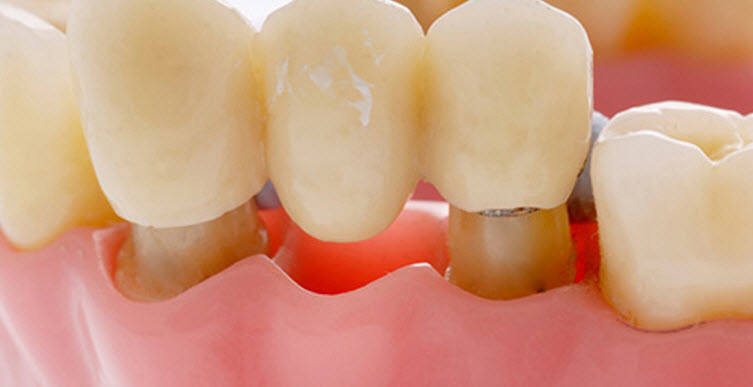Lateral teeth (molars, premolars) are exposed to high loads on a regular basis, and their anatomic structure and position in the dental arch make them more difficult to care for. Therefore, masticatory units deteriorate faster due to various traumas and dental diseases. Prosthetics for molars and premolars requires the use of durable and strong materials that can withstand serious chewing stresses. Crowns – prosthetic constructions for single restorations, indicated when the destruction of the upper part of the tooth by more than 60%, when the placement of fillings is ineffective.

Indications for crowns on the chewing tooth
- The supragingival part of the tooth is more than 60% decayed, or only the root is left;
- Abnormal size, location and shape of the tooth;
- Fracture of the crown part;
- Change of color, shape of molar, premolar due to disease, trauma;
- Abnormal wear and tear of enamel;
- Absence of a tooth in the dental arch (in a bridge).
Types of dental crowns on chewing teeth
Molars and premolars are millstones that grind up food before it enters the esophagus. They experience a high load, which can exceed 75 kg per 1 cm2. Therefore, the masticatory units are characterized by a massive size, a surface with many protruding tubercles. To restore molars and premolars, strong, durable materials capable of withstanding the increased load are used. Orthopedic dentistry offers the following types of crowns for molars:
- Metal – durable, corrosion-resistant, with a lifespan of up to 10-12 years. The list of materials used to create these designs includes: nickel-chromium alloy, cobalt-chromium alloy, titanium, precious metal alloys (platinum, silver, gold, palladium). All-metal alloy dentures can be with or without plating. These are the most inexpensive crowns, but the aesthetics leave much to be desired. Designs containing gold are characterized by high plasticity and fit precisely to the residual limb of the tooth. The disadvantages of these types of prostheses are excessive wear of the opposing tooth (molar, premolar on the opposite jaw) during constant contact, low aesthetics, development of allergies to components of the metal alloy (beryllium, chromium and nickel).
- Porcelain-fused-to-metal crowns are reliable, strong prostheses with a metal frame covered with a layer of ceramic. Metal-ceramic crowns are quite aesthetic, with an optimal ratio of reasonable price to good quality. Over time, the metal base begins to show through the gingiva (gray band effect), which negatively affects the aesthetics. Therefore, these types of crowns are not recommended for the teeth along the smile line.
- Zirconia crowns are strong, durable structures, which retain their original appearance over their entire lifespan (more than 15 years). They are aesthetically equal to ceramics, providing a natural-looking tooth. Biocompatible material is suitable for patients with metal allergies, it is used for restorations in the frontal and masseter areas. Designs are made using CAD/CAM technology, on a robotic machine, by milling. This rules out any errors or irregularities and provides precise adhesion to the core build-up and gingiva, taking into account the occlusion of the jaws and bite features.
- Metal/plastic is an inexpensive restoration which is a metal alloy frame lined with plastic material. Due to the porous nature of the material, the surface of the denture quickly darkens, absorbs dyes and odors from foods, beverages and cigarettes. The metal alloy can provoke inflammation and allergies. Service life is up to 3 years. Usually these products are used for temporary prosthetics, they are not reliable as a permanent restoration.
- Ceramic crowns are not suitable for the restoration of molars and premolars. The brittle ceramics are not able to withstand the high chewing pressure that often results in chipping and cracking. Ceramic crowns are used on front teeth, where the main criterion is good aesthetics. Incisors and canines are not subjected to high loads, but are involved in the formation of a smile and are visible when speaking. Ceramic restorations are identical to natural enamel in color, transparency and do not stand out.
Stages of placement of a crown on a masticatory tooth
- Diagnosis: a comprehensive examination (orthopantomogram, 3d scan), the dentist determines the general state of the mouth, identifies dental problems, contraindications, develops a treatment plan, and selects the best option for an orthopedic structure.
- Preparation – the doctor cleanses the mouth (plaque and calculus removal), treats teeth and gums (if necessary). The tooth is prepared for crowning by preparing the enamel, taking the proper shape of the residual limb, removing the nerve, filling the root canals, and if necessary, strengthening the root with a post or inlay. The application of zirconia constructions requires minimal cutting of material.
- Impressions – the doctor takes impressions of the patient’s jaw, according to which the prosthesis is made in the laboratory. To protect the tissue, a temporary plastic crown is placed on the prepared tooth.
- The ready-made crown is tried on, corrected if necessary, and fixed with dental cement.
The best crowns for chewing teeth
Since the main requirements for dentures on molars and premolars are the strength and durability of prosthetic systems, the best crowns for masticatory teeth are made of zirconium or metal-ceramic. Zirconia is the strongest, lightest material and requires minimal preparation of the supporting tooth, which is a big advantage over metal-ceramic products. The doctor decides which restoration to use in a particular case after a detailed assessment of the clinical picture, the characteristics of the patient’s body, his or her wishes and financial capabilities.
